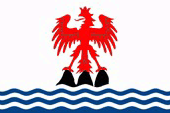Nizza |
|
|
|
| Übersicht – Contents: | |
Nizza |
|
|
|
| Übersicht – Contents: | |
Flagge – Flag: |
|
 |
Flagge von Nizza – flag of Nice – drapeau de Nice, Quelle/Source, nach/by: Die Welt der Flaggen |
| andere Flaggen – other Flags: | |
 |
ab/from 1999, Flagge der Region Provence-Alpes-Côte d’Azur – flag of Provence-Alpes-Côte d’Azur Region – drapeau de la région Provence-Alpes-Côte d’Azur, Quelle/Source, nach/by: Flags of the World |
| Die Flagge der Grafschaft Nizza ist eine Wappenflagge, sie zeigt das Bild des Wappens der Stadt. | The flag of the County of Nice is a scutcheon-flag, it shows the image of the coat of the city. |
| Seit 1999 wird in der Region "Provence-Alpes-Côte d’Azur" – zu der Nizza gehört – eine inoffizielle Flagge verwendet, welche die Heraldik der Grafschaft Barcelona (die Provence gehörte 1112–1245 zur Grafschaft Barcelona), der Grafschaft Dauphiné und der Grafschaft Nizza kombiniert. | Since 1999 is in the region of "Provence- Alpes-Côte d’Azur" – to which Nice belongs – an unofficial flag in use, which combines the features of the heraldry of the County of Barcelona (Provence belonged from 1112 to 1245 to the County of Barcelona), of the County of Dauphiné and of the County of Nice. |
| Quelle/Source: Volker Preuß | |
| Wappen – Coat of arms: | |
 |
Wappen der Grafschaft Nizza – Coat of arms of the County of Nice –
Blason du Comté de Nice, Quelle/Source, nach/by: Wikipedia (FR) |
| Das Wappen von Nizza zeigt einen silbernen Schild, darauf einen roten Adler mit roten Kleestängeln und roter Krone. Er steht auf einem schwarzen Dreiberg, der aus blauen Wellen ragt. Es gibt auch Darstellungen, in denen der Adler golden bewehrt ist und eine goldene Krone trägt und der Dreiberg wird vereinzelt auch grün wiedergegeben. | The coat
of arms of Nice shows a silvery shield, on it a red eagle with red clover
stems and a red crown. It stands on a black three-mountain, which rises from
blue waves. There exist also representations in which the eagle is golden armed and wears a golden crown, and the three-mountain is sporadically displayed in green. |
| Quelle/Source: Wikipedia (FR), Volker Preuß | |
|
Die Regionen: Die historischen, französischen Regionen – The historical, french Regions |
|
|
in Schwarz: Provinz und Gouvernement im Jahre 1776, in Rot: ehemalige
Grafschaft, Provinz oder Gouvernement – in black: governorate and province in 1776, in red: former county, province oder governorate |
| Landkarte/Map: Volker Preuß |
| Erläuterungen zu den Regionen | Explanation about the Regions |
| Die bis zur Französischen Revolution bestehenden Provinzen (bzw. Gouvernements) waren historisch gewachsene Gebilde, die sich oft aus ehemaligen Lehensgebieten der französischen Krone, historischen Grafschaften und Herzogtümern heraus entwickelt hatten, oft über hunderte von Jahren bestanden und Regionalität (kulturelle Besonderheiten und regionale Sprachen) bewahrt hatten. Der Französischen Revolution waren solche Erscheinungen natürlich nicht erwünscht, und im Rahmen ihrer blutigen und gewalttätigen Gleichmacherei wurden jegliche regionale Bezüge ausgemerzt. Kurz nach der Revolution wurden die Provinzen aufgelöst und Frankreich in viele kleine Départements aufgeteilt, die annähernd gleich groß und den gleichen Status haben sollten. Benannt wurden die Départements nach Flüssen oder Gebirgen, um auf keinen Fall den Namen einer der alten Provinz zu verwenden. Es gelang jedoch nicht, die Verbindungen der Einwohner Frankreichs zu ihrer jeweiligen Region abzuschneiden, so dass im Jahre 1960 wieder administrative Regionen geschaffen wurden, um bestimmte Verwaltungsprozesse regional steuern zu können. Dazu wurden Départements, die in einer bestimmten historischen Provinz lagen, zu einer historisch oft gleichnamigen Region administrativ zusammengefasst. Die dabei entstandenen Gebilde decken sich nur annähernd mit den Grenzen der historischen Provinzen. Im streng zentralistischen Frankreich wird jedwede Regionalität vermieden, so dass auch die offiziellen Flaggen dieser Regionen meist aussehen wie Flaggen von Firmen, lieblos, unhistorisch, technokratisch und modernistisch, die hier nicht Gegenstand lexikalischer Betrachtungen sein sollen. Nur in wenigen dieser Regionen gibt es offizielle Flaggen die an historische Vorbilder erinnern. Aber, sogar die Existenz dieser heutigen Regionen ist in Frage gestellt, denn im Jahr 2014 wurde eine Gebietsreform beschlossen, welche die Anzahl der Regionen ab dem Jahr 2016 durch Fusionen auf fast die Hälfte verringert. Jedoch gibt es für fast alle Regionen inoffizielle Flaggen, die an die alten Provinzen und die alte Heraldik erinnern sollen. | The until
the French Revolution existing provinces (or governorates) have been
historically grown structures, which had their roots oftenly in former
fiefdoms of the French crown, historic counties and duchies. They oftenly
existed for hundreds of years and had preserved regionality (e.g. cultural
particularities and regional languages). On the occasion of the French
Revolution such phenomena were of course not desirable, and as part of their
bloody and violent egalitarianism any regional references were eliminated. Shortly after the French Revolution the provinces were dissolved and France became divided into many départements, which should have approximately the same size and the same status. The départements were named after rivers or mountains, to use never and in no circumstances the name of an old province. However, there was no success in cutting the connections of the people of France to their respective regions, so that administrative regions were re-created in 1960, to have a better control in regional administrative processes. In this way became départements, which were placed in a historical province, administratively grouped to an oftenly historically named region. The resulted structures coincide only approximately with the boundaries of the old provinces. In the strictly centralist France any regionality is avoided, so that even the official flags of these regions mostly look like flags of companies, unloving, unhistorical, technocratic and modernistic, and these flags should not be a subject of any lexical considerations here. Only in a few of that regions, exist official flags which remember the historical models. But, even the existence of these today's regions is douptful, because in 2014 was passed a territorial reform valid from the year 2016, that reduces the number of the existing regions by merging to nearly the half. However, there exist unofficial flags in nearly all of these regions, which should remember the old provinces and the old heraldry. |
|
Wikipedia-Link zu den Regionen Frankreichs:
hier klicken FOTW-Link zu den Regionen Frankreichs: hier klicken |
Wikipedia
Link to the regions of France:
click here FOTW Link to the regions of France: click here |
| Quelle/Source: Flags of the World, Wikipedia (D), Volker Preuß | |
|
1382
· Johanna I. von Provence-Anjou setzt Ludwig I. (Herzog von Anjou, Bruder
von Karl V., König von Frankreich) zum Erben ein, die
Provence kommt an das Haus Anjou, es
entwickelt sich ein Thron- und Erbfolgekrieg 1388 · Graf Amadeus VII. von Savoyen, nutzt die Situation in der Provence und gliedert Stadt und Umgebung von Nizza seinem Herrschftsbereich an (Anschluss an das Fürstentum Piemont) 1416 · Savoyen, das zum Heiligen Römischen Reich Deutscher Nation gehört, wird zum Herzogtum erhoben, Herzog Amedeo VIII. kauft zusätzlich den Titel "Herzog im Piemont" vom Deutschen Kaiser Sigismund 1526 · Stadt und Umgebung von Nizza erhalten den offiziellen Namen Comté de Nice (Grafschaft Nizza) 1543 · Nizza wird französischen Truppen belagert und kurzzeitig erobert 1614 · Nizza wird Freihafen 1691–1697 · Pfälzischer Erbfolgekrieg, Nizza ist von französischen Truppen besetzt 1707–1713 · Spanischer Erbfolgekrieg, Nizza ist von französischen Truppen besetzt 1720 · Vereinigung von Savoyen-Piemont mit dem Königreich Sardinien, der Titel König von Sardinien kommt so an den Herzog von Savoyen, Errichtung des Königreichs Sardinien-Piemont durch das Haus Savoyen 1792 · Einmarsch der Französischen Revolutionsarmee, die Grafschaft Nizza wird an Frankreich angeschlossen 1814/15 · Wiener Kongress, Neuordnung Europas nach der Ära Napoléon, Wiederherstellung des Königreichs Sardinien-Piemont, die Grafschaft Nizza wird ebenfalls wieder hergestellt 1859 · italienischer Unabhängigkeitskrieg gegen Österreich, die Lombardei wird von Sardinien-Piemont (mit Unterstützung durch Frankreich) annektiert 1860 · Vertrag von Turin zwischen Frankreich und Sardinien-Piemont, Savoyen und Nizza werden an Frankreich abgetreten, heute gehört die Region zum Departement Alpes-Maritimes, und seit 1960, zusammen mit den Departements Alpes-de-Haute-Provence, Var, Vaucluse, Bouches-du-Rhône, Hautes-Alpes, zur Region Provence-Alpes-Côte d’Azur |
| 1382
· Joanna I. of Anjou-Provence proclaims Ludwig I. (Duke of Anjou, brother of
Charles V., King of France) as heir, the Provence
comes again to the House of Anjou, it begins a war of throne and war of
succession 1388 · Count Amadeus VII. of Savoy, takes advantage of the situation in the Provence and brings the city and the surroundings of Nice to his possessions (affiliation to the Principality of Piedmont) 1416 · Savoy, which is part of the Holy Roman Empire of German Nation, is raised to a duchy, Duke Amedeo VIII. buys in addition the title of the "Duke in Piedmont" from Sigismund, the German Emperor 1526 · city and surroundings of Nice, get the official name "Comté de Nice" (County of Nice) 1543 · Nice is besieged by French troops and conquered for a short time 1614 · Nice is freeport 1691–1697 · Palatinate War of Succession, Nice is occupied by French troops 1707–1713 · Spanish War of Succession, Nice is occupied by French troops 1720 · unification of Savoy-Piedmont with the Kingdom of Sardinia, the title of King of Sardinia comes in this way to the Duke of Savoy, establish of the Kingdom of Sardinia-Piedmont by the House of Savoy 1792 · invasion of the French Revolutionary Army, the County of Nice is annexed by France 1814/15 · Congress of Vienna, reorganization of Europe after the Napoleonic era, restoration of the Kingdom of Sardinia-Piedmont, the County of Nice is also restored 1859 · Italian War of Independence against Austria, the Lombardy gets annexed by Sardinia-Piedmont (supported by France) 1860 · Treaty of Turin between France and Sardinia-Piedmont, Savoy and Nice become ceded to France, today the region is part of the department of Alpes-Maritimes, and since 1960 – together with the departments of Alpes-de-Haute-Provence, Var, Vaucluse, Bouches-du-Rhône, Hautes-Alpes – part of the Region of Provence-Alpes-Côte d' Azur |
| Quelle/Source: Wikipedia (D) |
| Der Name "Nizza" geht auf das 4. Jahrhundert v.Chr. zurück, als die Phokäer aus der Gegend um Marseille die Ligurer besiegten und die Stadt Nikaïa (auch Nicaea) gründeten. Der Name bezieht sich auf die Siegesgöttin Nike und lässt sich mit "die Siegreiche" übersetzen. | The name "Nice" goes back to the 4th century B.C., when as the Phocaeans from the area around Marseille defeated the Ligurians and founded the city of Nikaïa (also Nicaea). The name refers to the goddess of victory, Nike, and can be translated with "the Victorious". |
| Quelle/Source: Wikipedia (D), Volker Preuß | |